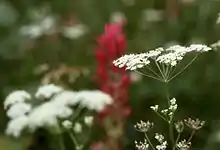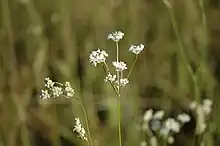| Perideridia | |
|---|---|
 | |
| Perideridia gairdneri subsp. borealis | |
| Scientific classification | |
| Kingdom: | Plantae |
| Clade: | Tracheophytes |
| Clade: | Angiosperms |
| Clade: | Eudicots |
| Clade: | Asterids |
| Order: | Apiales |
| Family: | Apiaceae |
| Subfamily: | Apioideae |
| Tribe: | Oenantheae |
| Genus: | Perideridia Rchb. |
| Type species | |
| Perideridia americana | |
| Species | |
|
About 12; see text | |
Perideridia is a genus of plants in the family Apiaceae. Plants in this genus are known generally as yampah or yampa. They are native to western North America. Similar in appearance to other plants of the family Apiaceae, they have umbels of white flowers.
Name
The genus is based on the Greek word perideri, meaning 'necklace'.[1]
Description
The plants have a unique appearance for members of the parsley family, and are tall (1–3 feet) and grasslike, with threadlike leaves 1–6 inches long that resemble blades of grass. The plants effectively mimic tall grass and are virtually invisible until they flower, since they tend to grow in grassy meadows, and prefer full sunlight. Like most members of the parsley family, yampah produces umbels of white flowers.[1] The small roots of yampah are about the size of a large unshelled peanut.
Distribution and habitat
The plants are widely distributed in moist open meadows and hillsides up to 7,500 feet (2,300 m) across Western North America.[2]
Uses
Plains Indians named the plant 'Yampah' and consumed its starchy bulbs, some of which taste like carrots.[1]
Perideridia gairdneri was an important staple crop of Native Americans in Western North America. The nutlike roots of the plant are crunchy and mildly sweet, and resemble water chestnuts in texture and flavor.
Yampah roots were either baked or steamed, and were reported to have excellent flavor and nutritional qualities. The seeds of yampah were used as a seasoning and resemble caraway seeds in flavor. Yampah roots contain rapidly assimilatable carbohydrates, and were used by hunters and runners as a high energy food to enhance physical endurance.
Uncooked yampah roots are a gentle laxative if consumed in excess and were used medicinally for this purpose.[2]
It resembles the highly toxic poison hemlock and water hemlock.
Species
| Image | Name | Common name | Distribution | Cytology[3] |
|---|---|---|---|---|
.jpg.webp) | Perideridia americana | eastern yampah | Midwestern United States | n=20 |
| Perideridia bacigalupii | Mother Lode yampah, Bacigalupi's yampah | Sierra Nevada foothills, California | ||
.jpg.webp) | Perideridia bolanderi | Bolander's yampah | western United States | n=19 |
| Perideridia californica | California yampah | Central Coast Ranges and a section of the Sierra Nevada foothills, California | n=22 | |
 | Perideridia erythrorhiza | redroot yampah, western yampah | Oregon in the United States | |
 | Perideridia gairdneri | Gardner's yampah, common yampah, Indian caraway | western North America from southwestern Canada to California to New Mexico | n=40,60 |
| Perideridia howellii | Howell's yampah | Oregon and northern California | n=20 | |
.jpg.webp) | Perideridia kelloggii | Kellogg's yampah | San Francisco Bay Area, and the Sierra Nevada foothills, California | n=20 |
| Perideridia lemmonii | Lemmon's yampah | from southeastern Oregon, western Nevada, and the mountains of eastern California | ||
| Perideridia leptocarpa | narrowseed yampah | California, Oregon | n=17 | |
| Perideridia montana | Gairdner's Yampah | Montana | ||
 | Perideridia oregana | Oregon yampah, squaw potato | Oregon and California in the western United States | n=8, 9, 10 |
 | Perideridia parishii | Parish's yampah, Sierra Queen Anne's lace | southwestern United States | n=19 |
| Perideridia pringlei | adobe yampah | California | n=20 | |
References
- 1 2 3 Taylor, Ronald J. (1994) [1992]. Sagebrush Country: A Wildflower Sanctuary (rev. ed.). Missoula, MT: Mountain Press Pub. Co. p. 98. ISBN 0-87842-280-3. OCLC 25708726.
- 1 2 Gregory L. Tilford (1997). Edible and Medicinal Plants of the West. Mountain Press Publishing. ISBN 978-0-87842-359-0.
- ↑ Stephen R. Downie; Feng-Jie Sun; Deborah S. Katz-Downie & Gina J. Collett (2004). "A Phylogenetic Study of Perideridia (Apiaceae) Based on Nuclear Ribosomal DNA ITS Sequences" (PDF). Systematic Botany. 29 (3): 737–751. doi:10.1600/0363644041744437. S2CID 37252459. Archived from the original (PDF) on 2019-01-22.